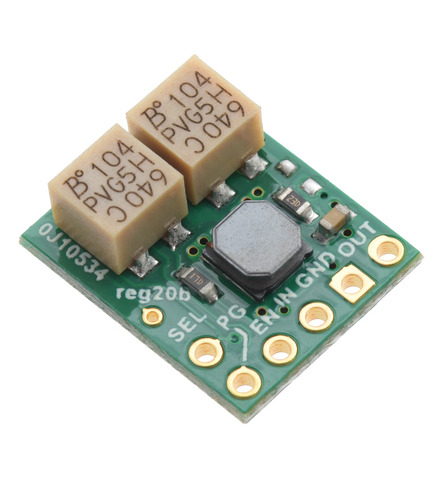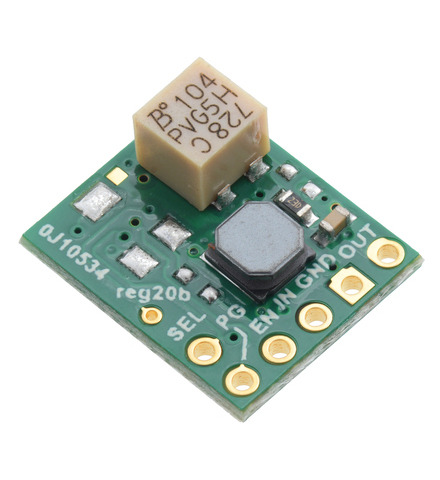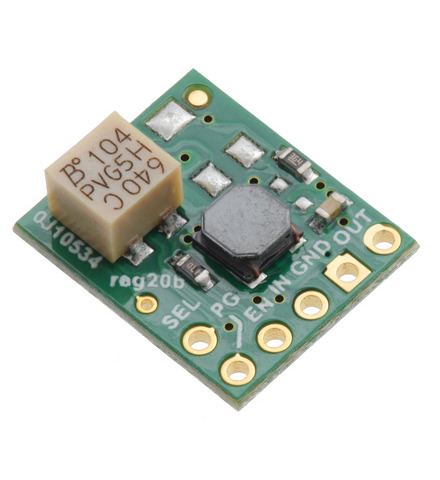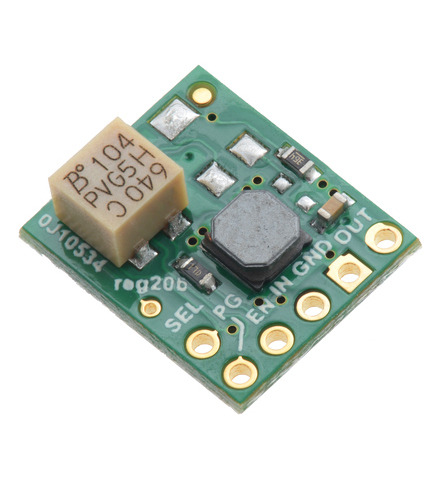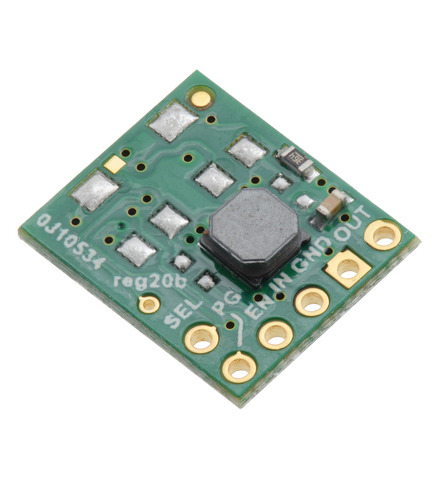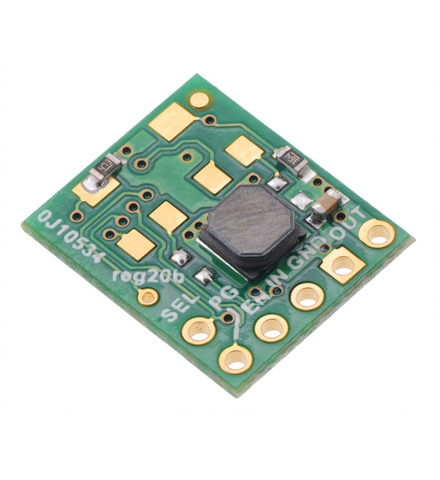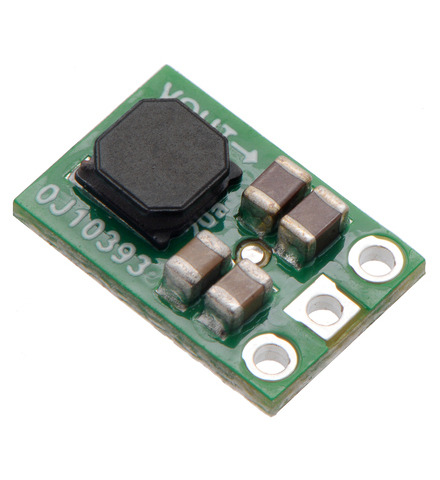The S9V11x family of efficient switching regulators (also called switched-mode power supplies (SMPS) or DC-to-DC converters) use a buck-boost topology to convert both higher and lower input voltages to a regulated output voltage. They take input voltages from 2 V to 16 V and increase or decrease them as necessary, offering a typical efficiency of over 85% and a typical output current of up to 1.5 A. The flexibility in input voltage offered by this family of regulators is especially well-suited for battery-powered applications in which the battery voltage begins above the regulated voltage and drops below as the battery discharges. Without the typical restriction on the battery voltage staying above the required voltage throughout its life, new battery packs and form factors can be considered.
The different members of this family offer different output voltage options, from fixed voltages with selectable alternatives to adjustable voltages that can be set anywhere between 2.5 V and 9 V using a precision 12-turn potentiometer. Some versions also have an adjustable low-voltage cutoff that can be set anywhere in the 2 V to 16 V output voltage range and used to prevent your battery from over-discharging. This is particularly useful for battery chemistries that can be damaged when over-discharged, including Li-ion and LiPo. The chart below lists all the regulators in the S9V11x family along with the key features of each version:
| Regulator |
Output voltage |
Typical max current output* |
Input voltage range |
Low-voltage cutoff |
Size |
Price |
 |
#2868 S9V11MACMA |
2.5 V – 9 V (fine-adjust) |
1.5 A |
2 V – 16 V
(3 V startup) |
fine-adjust |
0.50″ × 0.60″ × 0.25″ |
$22.95 |
 |
#2869 S9V11MA |
2.5 V – 9 V (fine-adjust) |
– |
$15.95 |
 |
#2870 S9V11F5S6CMA |
5 V (6 V selectable) |
fine-adjust |
$15.95 |
| #2871 S9V11F3S5CMA |
3.3 V (5 V selectable) |
fine-adjust |
$15.95 |
 |
#2872 S9V11F3S5 |
3.3 V (5 V selectable) |
– |
0.50″ × 0.60″ × 0.17″ |
$11.95 |
| #2873 S9V11F3S5C3 |
3.3 V (5 V selectable) |
3 V (fixed) |
$11.95 |
 |
#2836 S9V11F5 |
5 V |
– |
0.30″ × 0.45″ × 0.17″ |
$12.95 |
| *For input voltages close to the output. Actual achievable maximum continuous current is a function of input and output voltage and is limited by thermal dissipation. See the output current graphs on the product pages for more information. |
 | Step up/step down regulator S9V11F5S6CMA on a breadboard. |
|---|
|
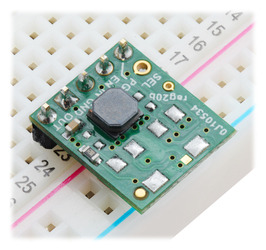 | Step up/step down regulator S9V11F3S5 on a breadboard. |
|---|
|
These regulators have short-circuit protection, and thermal shutdown prevents damage from overheating; they do not have reverse-voltage protection. Note that the startup current is limited to approximately 700 mA until the output voltage reaches the nominal voltage; after startup, the available current is a function of the input voltage (see the Typical efficiency and output current sections on the product pages for more information).
 Compare all products in this category
Compare all products in this category
Products in category “S9V11x Step-Up/Step-Down Voltage Regulators”
| Output voltage |
Typical max output current* |
Input voltage range* |
Low-voltage cutoff |
Size |
| 2.5 V – 9 V (fine-adjust) |
1.5 A |
2 V – 16 V |
fine-adjust |
0.5″ × 0.60″ × 0.25″ |
*For input voltages close to the output. Actual achievable maximum continuous current is a function of input and output voltage and is limited by thermal dissipation. See the output current graphs on the product page for more information.
| Output voltage |
Typical max output current* |
Input voltage range* |
Low-voltage cutoff |
Size |
| 2.5 V – 9 V (fine-adjust) |
1.5 A |
2 V – 16 V |
– |
0.5″ × 0.60″ × 0.25″ |
*For input voltages close to the output. Actual achievable maximum continuous current is a function of input and output voltage and is limited by thermal dissipation. See the output current graphs on the product page for more information.
| Output voltage |
Typical max output current* |
Input voltage range* |
Low-voltage cutoff |
Size |
| 5 V (6 V selectable) |
1.5 A |
2 V – 16 V |
fine-adjust |
0.5″ × 0.60″ × 0.25″ |
*For input voltages close to the output. Actual achievable maximum continuous current is a function of input and output voltage and is limited by thermal dissipation. See the output current graphs on the product page for more information.
| Output voltage |
Typical max output current* |
Input voltage range* |
Low-voltage cutoff |
Size |
| 3.3 V (5 V selectable) |
1.5 A |
2 V – 16 V |
fine-adjust |
0.5″ × 0.60″ × 0.25″ |
*For input voltages close to the output. Actual achievable maximum continuous current is a function of input and output voltage and is limited by thermal dissipation. See the output current graphs on the product page for more information.
| Output voltage |
Typical max output current* |
Input voltage range* |
Low-voltage cutoff |
Size |
| 3.3 V (5 V selectable) |
1.5 A |
2 V – 16 V |
– |
0.5″ × 0.60″ × 0.17″ |
*For input voltages close to the output. Actual achievable maximum continuous current is a function of input and output voltage and is limited by thermal dissipation. See the output current graphs on the product page for more information.
| Output voltage |
Typical max output current* |
Input voltage range* |
Low-voltage cutoff |
Size |
| 3.3 V (5 V selectable) |
1.5 A |
2 V – 16 V |
3 V (fixed) |
0.5″ × 0.60″ × 0.17″ |
*For input voltages close to the output. Actual achievable maximum continuous current is a function of input and output voltage and is limited by thermal dissipation. See the output current graphs on the product page for more information.
| Output voltage |
Typical max output current* |
Input voltage range* |
Low-voltage cutoff |
Size |
| 5 V |
1.5 A |
2 V – 16 V |
– |
0.30″ × 0.45″ × 0.17″ |
*For input voltages close to the output. Actual achievable maximum continuous current is a function of input voltage and is limited by thermal dissipation. See the output current graphs on the product page for more information.
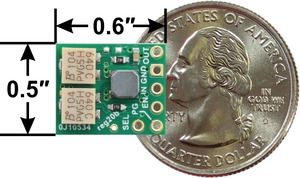





 Compare all products in this category
Compare all products in this category









